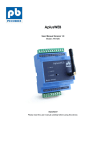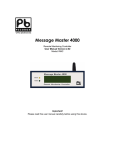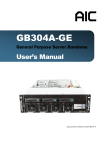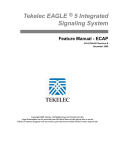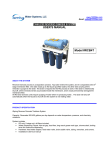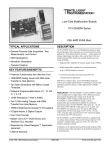Download GSW WATER HEATING User's Manual
Transcript
GSW WATER HEATING
599 Hill Street West
Fergus, ON, Canada N1M 2X1
STORAGE BOOSTER TANKS
INSTALLATION AND OPERATING INSTRUCTIONS
Read and understand these instructions thoroughly before starting
TABLE OF CONTENTS
I) Introduction . . . . . . . . . . . . . . . . . . . . . . . . . . . .2
II) Safety . . . . . . . . . . . . . . . . . . . . . . . . . . . . . . . . .2
III) Installation . . . . . . . . . . . . . . . . . . . . . . . . . . . . .2
IV) Operation . . . . . . . . . . . . . . . . . . . . . . . . . . . . . .5
V) Maintenance . . . . . . . . . . . . . . . . . . . . . . . . . . . .5
Warranty . . . . . . . . . . . . . . . . . . . . . . . . . . . . . . .7
PLEASE RETAIN THESE INSTRUCTIONS IN A
SAFE LOCATION FOR FUTURE REFERENCE
WARNING:
Improper installation, adjustment, alteration, service, or maintenance can cause
injury or property damage. Refer to this
manual. For assistance or additional information, consult a qualified installer, service agency, or the electric utility.
FOR YOUR SAFETY
• Do not store or use gasoline or other
flammable vapors and liquids in the
vicinity of this or any other appliance.
• Installation and service must be performed by a qualified installer, service
agency or the electric utility.
WARNING:
If the information in these instructions is
not followed exactly, a fire or explosion
may result causing property damage, personal injury or death.
GSW Water Heating is a division of GSW Water Products Inc.
PART NO. 71772 C (05-02)
I) INTRODUCTION
III) INSTALLATION
Thank you for purchasing this storage booster tank.
Properly installed and maintained, it will provide years of
trouble free service.
WARNING
Excessive Weight Hazard
Use two or more people to move and install
storage booster tank. Failure to do so can
result in back or other injury.
The warranty on this storage booster tank is in effect only
when the tank is installed and operated in accordance with
these instructions. The manufacturer of this tank will not be
liable for any injury or property damage resulting from failure to comply with these instructions.
CAUTION
Hydrogen gas can be produced in a hot water system
served by this storage tank that has not been used for a
long period of time (generally two (2) weeks or more).
Hydrogen gas is extremely flammable and can ignite
when exposed to a spark or flame. To reduce the risk of
injury under these conditions, it is recommended that the
hot water faucet be opened for several minutes at the
kitchen sink before using any electrical appliance connected to the hot water system. Use caution in opening
faucets. When hydrogen is present, there will probably be
an unusual sound such as air escaping through the pipe
as the water begins to flow. There should be no smoking
or open flame near the faucet at the time it is open.
IMPORTANT: Read and understand these instructions
before installing and operating your storage booster tank.
Description
The JOHN WOOD series of storage booster tanks, available in 40, 50 or 80 gallon sizes, have been designed to
supply hot water for domestic use when combined with a
tankless coil boiler or other water heating source. Each tank
is equipped with an adjustable thermostat, pre-wired and
ready for connection to a circulator pump (not supplied).
These tanks are not constructed to ASME requirements and
should not be used for such applications.
II) SAFETY
Relief Valve Requirements
Local Codes
The installation of this storage tank must be In accordance
with these Instructions and all applicable local codes.
WARNING
For protection against excessive temperatures and pressure, install temperature and pressure protective equipment required by local codes, but no less than a combination Temperature and Pressure (T&P) Relief Valve certified as meeting the requirements for Relief Valves and
Automatic Gas Shutoff Devices for Hot Water Supply
Systems, ANSI Z21.22, by a nationally recognized testing laboratory that maintains periodic inspection of production of listed equipment or materials. The valve shall
be marked with a maximum set pressure not to exceed
the maximum working pressure of the storage tank. The
T&P valve shall be rated for the BTU INPUT of the entire
system.This T&P valve may be in addition to any T&P
valve that is required on the boiler, or other energy supply
system. Install the valve into the opening provided on the
storage tank, or other approved system location. Provide
tubing so that any discharge from the valve will exit within
152mm (6 in.) above, or any distance below the structural floor and cannot contact any live electrical part. The end
of the relief pipe opening should terminate near the floor
drain or other suitable location. Do not place a valve(s) or
any other blockage or restrictions between the tank and
the T&P valve.
Location
IMPORTANT:
This storage booster tank must be installed strictly in
accordance with the instructions enclosed, and local electrical, fuel and building codes. It is possible that connections to the tank, or the tank itself, may develop leaks. IT
IS THEREFORE IMPERATIVE that the storage booster
tank be installed so that any leakage of the tank or related water piping is directed to an adequate drain in such a
manner that it cannot damage the building, furniture, floor
covering, adjacent areas, lower floors of the structure or
other property subject to water damage. This is particularly important if the tank is installed in a multi-story building,
on finished flooring or carpeted surfaces. GSW WILL NOT
ASSUME ANY LIABILITY for damage caused by water
leaking from the storage booster tank, pressure relief
valve, or related fittings. Select a location as centralized
within the piping system as possible. In any location
selected, it is recommended that a suitable drain pan be
installed under the storage booster tank. This pan must
limit the water level to a MAXIMUM depth of 45mm (1 3/4
in.) and have a diameter that is a minimum of 50mm (2 in.)
greater than the diameter of the storage booster tank.
Suitable piping shall connect the drain pan to a properly
operating floor drain.
T&P Valve Check
Inspect the relief valve annually to ensure proper operation.
This involves opening the valve to check that it is flowing
freely and that there are no blockages and letting it snap
shut (see “MAINTENANCE” section).
Locate the storage tank in a clean dry area close to the
water heating source and preferably central to the piping
system. Adequate clearance for accessibility to permit main-
-2-
tenance and service must be provided. Water lines and the
storage tank should be protected from freezing temperatures. Do not install the storage tank in outdoor unprotected
areas. It is desirable to have a floor drain nearby to permit
easy draining if necessary.
WARNING
The water heating source piping and components connected to the tank must be suitable for potable water use.
TOXIC chemicals such as used for boiler treatment must
not be introduced into the tank.
Circulator Pump
A circulator pump is not supplied. Use only a bronze body
model rated for 110/120 volts, 60Hz. Install in accordance
with the pump manufacturer’s instructions using standard
plumbing practices.
Plumbing Connections
The main parts and features of your storage booster tank
are identified in Figure 1. Install plumbing according to
Figure 2 for single storage tank and according to Figure 3
for multiple storage tank systems.
1. Ensure the storage tank is level before starting installation.
T&P VALVE (SOME
MODELS WILL HAVE
A SIDE MOUNT FOR
THIS VALVE)
IMPORTANT
Do not apply heat directly to tank fittings when making
sweat connections. They contain non-metallic material.
2. Install circulation loop as shown using 19mm (¾ in.)
copper pipe.
3. Install the cold water supply piping into a tee between
the circulator discharge and the boiler coil inlet.
4. Connect the boiler supply line to the combination return
and drain valve.
5. Connect hot water supply to top tank fitting.
6. Install 19mm (¾ in.), 150 psi Temperature and Pressure
Relief Valve into the tank as shown.
7. A check valve may be installed between the cold water
tee connection and the circulator. This will force the cold
water through the coil first.
NOTE: The check valve can often be noisy and cause
reduced supply pressures. For multiple storage tank sysCHECK VALVE
EXPANSION TANK (OPTIONAL)
CIRCULATOR
PUMP
PRESSURE
REGULATOR
(OPTIONAL)
T&P VALVE
HOT
COLD
T&P VALVE
(FOR SOME
MODELS)
SUPPLY (TO BOILER
TANKLESS COIL)
JUNCTION BOX
HOT
STORAGE
BOOSTER
TANK
HOT
WATER
OUTLET
TANKLESS
COIL BOILER
COMBINATION RETURN
& DRAIN VALVE
Figure 2: Single Storage Booster Plumbing Diagram
ANODE
CHECK VALVE
EXPANSION TANK (OPTIONAL)
CIRCULATOR
PUMP
T&P VALVE
HOT
THERMOSTAT
CONTROL
PRESSURE
REGULATOR
(OPTIONAL)
T&P VALVE
HOT
CHECK
VALVE
ACCESS
DOORS
STORAGE
BOOSTER
TANK
STORAGE
BOOSTER
TANK
T&P VALVE
(FOR SOME
MODELS)
COLD
HOT
TANKLESS
COIL BOILER
COMBINATION
RETURN &
DRAIN VALVE
Figure 1: Main Parts and Features
THERMOSTAT
RETAINER
COMBINATION RETURN
& DRAIN VALVE
Figure 3: Multiple Storage Booster Plumbing Diagram
-3-
tem, check valves must be installed to prevent the circulator
from pumping hot water into another tank and overheating
it.
8. The use of a pressure regulator is optional, but recommended when the cold supply pressure is over 80 psi.
Reducing the inlet pressure to 45-60 psi will reduce
probability of relief valve discharge by thermal expansion.
9. The water utility supply meter may contain a check
valve, back-flow preventer or water pressure reducing
valve. This will create a closed water system. During the
heating cycle, the water expands creating a pressure
build-up in the water system. A Temperature and
Pressure (T&P) Relief Valve must be installed (150 psi
maximum pressure). See preceding section. If the T&P
valve discharges periodically, this may be due to thermal expansion in a closed system. To prevent this condition and to reduce the possible build up of lime on the
Temperature and Pressure Relief Valve seat, either one
of the following installations is required;
i) Install a 125 psi pressure relief valve in the cold water
supply line. Make sure that the discharge of this valve is
protected from freezing and directed to an open drain.
ii) Install an expansion tank on the cold water supply
line.
10. A vacuum relief valve may be installed to provide venting of a closed system. Check local code requirements.
NOTE: When filling, avoid water leakage. Do not allow the
insulation of the tank to get wet as water can cause electrical malfunction or reduce the effectiveness of the insulation.
1. To insure complete filling of the tank, allow air to exit by
opening a hot water faucet that is served by the tank
and is some distance away from the heater.
2. Ensure the storage tank drain valve is closed.
3. Open the cold water supply valve and fill the tank and
piping system with water. When an uninterrupted
stream of water, without apparent air bubbles, flows
from the open hot water faucet, the system is full.
4. Close the open hot water faucet. Check the system for
leaks, repair as necessary and retest.
5. Connect a hose to the drain valve and route to a suitable drain. Open the drain valve and let water run to
flush out any foreign matter that may have entered the
system. Once flushed, close the drain valve and disconnect hose.
Electrical Wiring
Temperature Regulation
120 VOLT SUPPLY
L1
nection at the service panel to the ground screw at the
junction box.
4. The thermostat is rated for a maximum inductive current
of 7 FLA at 120 VAC. Do not exceed this rating for the
circuit.
5. Do not install or connect electrical heating elements to
this tank.
Filling
DANGER
CIRCULATOR
PUMP
L2
JUNCTION BOX
(AT CASING TOP)
BOOSTER TANK
MUST BE
GROUNDED TO
THE ELECTRICAL
SUPPLY SERVICE.
WIRE CONNECTORS
BLACK
BLACK
In order to reduce the risk of scald injury, the thermostat is
factory set to 49°C (120°F). The thermostat operates automatically and can be adjusted to provide higher or lower
water temperature as needed. A mixing valve in connection
with a higher temperature setting should be used to reduce
risk of scald injury.
THERMOSTAT
IF WIRE HAS TO BE REPLACED IN THE FIELD,
USE ONLY TYPE TEW 105°C WIRE.
Figure 4: Wiring Diagram
Electrical wiring must be in accordance with local codes; or
in the absence of local codes with the National Electrical
code ANSI/NFPA 70 or The Canadian Electrical Code, as
applicable.
1. Supply 110/120 volt, 60Hz power, to the junction box
located at the top of the tank.
2. Connect the circulator pump in series with the thermostat as shown in Figure 4.
3. A ground wire must be supplied from the ground con-
-4-
CAUTION
Increasing the thermostat setting above the pre-set temperature may cause severe burns and consume excessive energy. Hotter water increases the risk of scald injury.
IMPORTANT
RISK OF SCALDING. Hot water will cause third degree
burns in 6 seconds at 60°C (140°F), in 30 seconds at 54°
(130°F).
IV) OPERATION
1. Follow boiler or heat source installation and operating
instructions.
2. Fill the tank (see “FILLING” section).
3. The boiler or water heating source should be set to provide at least 11°C (20°F) higher water temperature than
the temperature setting of the storage tank
4. Turn power on, check for proper operation of boiler and
storage tank.
Temperature Adjustment
The setting of 49°C (120°F) has been proven to be satisfactory from the standpoint of operational costs and safety.
We recommend the thermostats remain set at 49°C
(120°F).
If water temperature adjustment is required:
1. Turn "OFF" the electrical supply to the tank.
2. Remove lower access door.
3. Turn back insulation.
4. Adjust thermostat to water temperature desired.
5. Replace insulation and access door.
6. Turn "ON" the electrical supply to the tank.
V) MAINTENANCE
T&P Valve Check
CAUTION
The out-flowing water is hot. Avoid splashing the water on
yourself or on the surroundings where it may cause damage.
Do not attempt to operate this storage tank with the cold
water inlet valve closed. The Temperature and Pressure
Relief Valve must be manually operated at least once a
year. This involves opening the valve to check that it is flowing freely and that there are no blockages. WARNING!
WATER MAY BE HOT and water flow can be forceful.
Caution should be taken to ensure that:
1. No one is in front of or around the outlet of the T&P
valve discharge line.
2. The water manually discharged will not cause any bodily injury or property damage. The water may be
extremely hot.
While standing clear of the outlet (discharge water may be
hot), lift the lever and let it snap shut. The water should stop
Temperature and Pressure
Relief Valve
Manual Relief Valve
Discharge line to drain
Figure 5: T&P Valve Test
immediately. If it fails to reset completely and continues to
release water, the valve is not functioning properly and must
be replaced immediately. Close the cold water supply valve,
drain the tank as directed in the “Draining and Flushing”
section, and replace the T&P valve with a new one. Failure
to install and maintain an approved T&P valve will release
the manufacturer from any claim that might result from
excessive temperature or pressure. In systems where the
relief valve discharges periodically, this may be due to thermal expansion or to a thermostat that is operating at too
high a temperature. If you suspect a malfunctioning thermostat, contact a qualified service technician for repairs.
Draining and Flushing
Some service work to be performed on the tank requires the
tank to be drained. It is also recommended that the tank be
drained and flushed every 6 months to remove any sediment and lime which may build up in the bottom of the tank
during operation. Such buildup can result in noisy operation.
To drain the tank:
1. Turn "OFF" the electrical supply to the tank.
2. Close the cold water supply valve.
3. Open a nearby hot water faucet served by the system.
4. Connect a hose to the drain valve and route it to an adequate drain.
CAUTION! The water being drained can be extremely
hot! The drain hose should be rated for at least 93°C
(200°F). If the drain hose does not have this rating, open the
cold water supply valve and a nearby hot water faucet
served by the system until the water flow is no longer hot.
Close the cold water supply valve and resume.
5. Open the drain valve and allow all the water to drain
from the tank.
6. Open the cold water supply valve and flush the tank as
needed to remove sediment and any other foreign matter that may have entered the system. Close the cold
water supply valve when clean water flows.
7. Perform any other servicing as required.
8. Close the drain valve, disconnect hose and refill the
tank (see “FILLING” section).
9. Turn "ON" the electrical supply to the tank.
Cathodic Protection
Your storage booster tank has been equipped with one or
more anodes that protect the tank from corrosion. Over
time, as the anode works, it slowly dissolves and must be
replaced. If the anode(s) is less than 10mm (3/8 in.) in diameter, or has any of the inner steel core exposed, it must be
replaced. Depending on water conditions, an anode can last
from one to ten years. Many localities treat their water and
this can have a significant effect on the life of your heater.
Water conditioning, such as over-softening, can accelerate
the rate at which the anode(s) is consumed. Rapid depletion
can leave a heater unprotected causing a premature failure.
It is good practice to check the anode(s) annually to see if it
needs replacing. Operating a storage tank without an
actively working anode(s) will void the warranty. Failure to
maintain the anode may result in premature failure of the
storage tank due to corrosion and leaks.
-5-
Anode Maintenance
1. Turn "OFF" the electrical supply to the tank.
2. Close the cold water supply valve.
3. Open a nearby hot water faucet served by the system
to depressurize the system.
4. Connect a hose to the drain valve and drain 22 litres (6
gal.) as directed in the “Draining and Flushing” section.
NOTE: The anode(s) has been factory installed using a
power tool. It may be necessary for a second person to stabilize the tank. A few sharp blows on the handle of the socket wrench should loosen the anode nut. If an impact wrench
(power drive) is available, this is an easy way to remove an
anode.
6. Using a 1 1/16" socket, remove anode(s) and inspect it.
The surface may be rough, full of pits and crevices, but
this is normal. If it is less than approximately 10mm (3/8
in.) in diameter, or the inner steel core is exposed, the
anode(s) should be replaced.
7. Apply Teflon® tape or sealing compounds approved for
use with potable water, to the threads of the anode(s)
and install into the tank top.
8. Open the cold water supply valve and open a nearby
hot water faucet to purge air from the tank as directed
in the “Filling” section.
9. Check for leaks, repair as required, and re-test.
10. Turn "ON" the electrical supply to the tank.
-6-
~ Certificate of Warranty ~
Warranty Code:
See Rating Label Serial Number prefix for
Warranty Code. Reduced warranty period
applies to Newfoundland.
Standard Warranty Years:
Reduced Warranty Years:
P R S T U V W
3 5 6 7 8 9 10
2 3 3 5 5 5 5
Y
12
7
For its GSW and John Wood water heaters and storage boosters ("Unit"), GSW Water Heating ("GSW") warrants that, upon
receipt of a properly verified Warranty claim within the Warranty Period, it will, at its election, repair or replace: units which leak or parts which are defective
in material or workmanship, subject to the terms and conditions set forth in this certificate. GSW will not assume any expense or liability for unauthorized
returns, nor repairs made by a person who has not been authorized by GSW or one of its authorized dealers. GSW Units/parts must be replaced with GSW or
John Wood products to be eligible for Warranty. This Warranty is available to the original owner of a Unit installed within the boundaries of continental United
States, of Canada, or their territories. Consumers must retain point-of-sale proof of purchase to validate warranty entitlement. This Warranty does not
cover components not manufactured by GSW, such as oil burners, which carry the warranty given by the manufacturer thereof, copy of which warranty GSW
will make available, to the extent supplied by the manufacturer, without recourse to GSW.
THERE ARE NO WARRANTIES WHICH EXTEND BEYOND THE DESCRIPTION ON THE FACE HEREOF. THIS EXPRESS
WARRANTY IS, WHERE PERMITTED BY LAW, IN LIEU OF AND EXCLUDES AND REPLACES ALL OTHER CONDITIONS,
WARRANTIES, GUARANTEES, REPRESENTATIONS, OBLIGATIONS OR LIABILITIES OF GSW OF ANY NATURE OR KIND,
EXPRESS OR IMPLIED, HOWEVER ARISING (WHETHER BY CONTRACT, CONDUCT, STATEMENT, STATUTE, NEGLIGENCE, PRINCIPLES OF MANUFACTURER'S LIABILITY, OPERATION OF LAW OR OTHERWISE) WITH RESPECT TO THE
UNIT OR ITS FITNESS FOR A PARTICULAR PURPOSE, MERCHANTABILITY, INSTALLATION, OPERATION, REPAIR OR
REPLACEMENT. GSW EXPRESSLY DISCLAIMS ANY AND ALL IMPLIED WARRANTIES. IN NO EVENT WILL GSW'S LIABILITIES EXCEED THE COST OF THE DEFECTIVE PART(S) OR UNIT. GSW WILL NOT PAY FOR ANY TRANSPORTATION,
LABOUR, INSTALLATION, OR OTHER INCIDENTAL COSTS ASSOCIATED WITH THE REPAIR OR REPLACEMENT OF A
DEFECTIVE PART OR UNIT.
This warranty and GSW's obligations shall be construed and determined in accordance with the laws of both the Province of Ontario, and of Canada in force
therein. This Warranty does not affect specific legal rights of a consumer under applicable law, except to the extent that such rights may be waived or replaced,
and the provisions hereof are deemed to be amended to the extent necessary. The unenforceability of any provision, in whole or in part, of this Certificate shall
not affect the remaining provisions. Any and all repair and/or replacement of part(s) or Unit are the sole and exclusive remedy available against GSW.
LIABILITY OF GSW COVERED BY THIS WARRANTY IS CONDITIONAL UPON THE FOLLOWING:
1.
2.
3.
4.
5.
6.
The Unit shall be installed in accordance with all manufacturers' instructions, all applicable equipment and building codes, ordinances and regulations (hereinafter referred to as the "standards").
The Unit must not be installed where water damage can result from a
leak, while provision(s) shall be made for directing any water escaping
from the Unit, to a properly operating drainpipe. As all units of this type
may eventually leak, you must protect against any potential water damage. GSW accepts no responsibility for such damage, nor any incidental
or consequential loss, nor damage(s) related thereto, suffered by the
owner of the Unit nor by any third party.
The Unit shall not be installed where it will be exposed to adverse or
unusual environmental or corrosive conditions. No warranty extends, for
example, and without limitation of the foregoing, to Units exposed to:
salts; chemicals; exhausts; pollutants or contaminants. Further, no warranty extends to Units affected by fire, freezing or flood, "Acts of God",
or any other contingency beyond the control of GSW.
The Unit shall be equipped with a properly operating temperature and
pressure relief valve as specified by GSW and applicable standards. The
Unit shall be operated at temperatures not exceeding the maximum setting of the thermostat and/or high limit control provided by GSW, and at
water pressures not exceeding the pressure reading stated on the Unit.
The Unit must be carefully inspected, maintained, and operated in accordance with the manufacturer's instructions. No warranty extends, for
example, and without limitation of the foregoing, to any Unit operated:
without the tank being completely filled with water; without an operating
anode; with levels of sediment or lime precipitate which cause failure; in
connection to any attachment(s), energy saving device(s), or other means
of heating, except as approved by GSW for the Unit; other than with
potable water without any additives such as salts, chlorine or chemicals,
except those added for the sole purpose of rendering the water fit for
domestic use.
All repairs must be made by a competent and qualified person who is certified, by GSW or one of its authorized dealers, to work on the Unit, using
factory approved replacement parts, and the Unit shall not be otherwise
modified, altered or improperly repaired.
7.
8.
9.
-7-
A properly documented claim shall be received by GSW or one of its
authorized dealers, or point of purchase, within the following Warranty
Period, except as provided otherwise below*:
a) for any defective part, within one (1) year; or
b) for any Unit that develops leaks in the inner tank due to rust, corrosion
or other chemical reactions caused by the potable domestic water supplied to your home, within the period of time shown in table at the top of
this page.
* Residential units installed and used in a commercial application carry a
warranty period of one (1) year from date of installation; and,
Any repair or replacement of any part, tank, or Unit under this Warranty
will not extend the Warranty Period beyond that calculated from the date
of first installation of the original Unit. The date of first installation will
be deemed to be the later of the date indicated by the Unit's serial number, or if supplied with the Warranty claim, the sales receipt, or installer's
receipt.
A claim under this Warranty must include the model and serial number of
the Unit, proof of date on which the Unit was first installed, and the identity of the defective part(s) for which a claim is being made and be submitted within 15 days following discovery of the defect(s), by personal
delivery to a GSW authorized dealer, point of purchase, or GSW itself at:
GSW Water Heating
GSW Water Heating is a division of GSW Water Products Inc.
599 Hill Street West
Fergus, ON Canada N1M 2X1
Should you have questions, please call our Technical Support Line at 1888-479-8324.
If requested by GSW, information relating to the purchase, transportation,
operation and installation of the Unit must be supplied. The defective
part(s) or Unit, with all components properly and securely packed, shall
be returned transportation pre-paid, to the address designated by GSW in
the written request. All claims are subject to validation by GSW.







